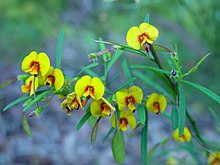| Eutaxia parvifolia | |
|---|---|

| |
| Scientific classification | |
| Kingdom: | Plantae |
| Clade: | Tracheophytes |
| Clade: | Angiosperms |
| Clade: | Eudicots |
| Clade: | Rosids |
| Order: | Fabales |
| Family: | Fabaceae |
| Subfamily: | Faboideae |
| Genus: | Eutaxia |
| Species: | E. parvifolia |
| Binomial name | |
| Eutaxia parvifolia Benth. | |
| Synonyms | |
Eutaxia parvifolia is a species of flowering plant in the family Fabaceae and is endemic to southwestern Western Australia. It is a shrub with reddish brown stems, elliptic to egg-shaped leaves with the narrower end towards the base, and mostly yellow, red or orange flowers, with yellow red or orange markings.
Description
Eutaxia parvifolia is an erect or prostrate, spindly, densely branched shrub that typically grows to a height of 0.2–2 m (7.9 in – 6 ft 6.7 in) and has reddish-brown, glabrous stems. The leaves are arranged in opposite pairs, elliptic to egg-shaped with the narrower end towards the base, 2.5–17 mm (0.098–0.669 in) long and 1–3 mm (0.039–0.118 in) wide on a petiole 1–3 mm (0.039–0.118 in) long. The flowers are arranged singly in leaf axils, often crowded near the ends of branchlets, each flower on a pedicel 1–2.4 mm (0.039–0.094 in) long. The sepals are ribbed and hairy, 4.5–7 mm (0.18–0.28 in) long and fused at the base. The petals are mostly yellow, red or orange with yellow, red or orange spots, streaks or blotches. The upright "standard" petal is 7.5–9 mm (0.30–0.35 in) long, the two "wing" petals 5.5–7.8 mm (0.22–0.31 in) long and the "keel" enclosing the stamens is 5–5.7 mm (0.20–0.22 in) long. Flowering occurs from August to December and the fruit is 4.5–7 mm (0.18–0.28 in) long and 2–3.5 mm (0.079–0.138 in) wide'
Taxonomy
Eutaxia parvifolia was formally described in 1837 by English botanist George Bentham in Enumeratio plantarum quas in Novae Hollandiae ora austro-occidentali ad fluvium Cygnorum et in sinu Regis Georgii collegit Carolus Liber Baro de Hügel, based on plant material collected by Charles von Hügel in King George Sound. The specific epithet (parvifolia) means "small-leaved".
Distribution and habitat
This eutaxia grows in heath and woodland between Bolgart, Albany and the Cape Arid National Park.
Conservation status
Eutaxia parvifolia is classified as "not threatened" by the Government of Western Australia Department of Parks and Wildlife.
References
- ^ "Eutaxia parvifolia". Australian Plant Census. Retrieved 5 December 2020.
- ^ Wilkins, Carolyn F.; Chappill, Jennifer A.; Henderson, Gemma R. (2010). "An account of Eutaxia (Leguminosae: Mirbelieae) with a focus on the Western Australian species" (PDF). Nuytsia. 20: 138–142. Retrieved 5 December 2020.
- ^ "Eutaxia parvifolia". FloraBase. Western Australian Government Department of Biodiversity, Conservation and Attractions.
- "Eutaxia parvifolia". APNI. Retrieved 5 December 2020.
- Bentham, George; Endlicher, Stephan (ed.) (1837). Enumeratio plantarum quas in Novae Hollandiae ora austro-occidentali ad fluvium Cygnorum et in Sinu Regis Georgii collegit Carolus liber baro de Hügel. New York. pp. 34–35. Retrieved 5 December 2020.
{{cite book}}:|first2=has generic name (help) - Sharr, Francis Aubi; George, Alex (2019). Western Australian Plant Names and Their Meanings (3rd ed.). Kardinya, WA: Four Gables Press. p. 271. ISBN 9780958034180.
| Taxon identifiers | |
|---|---|
| Eutaxia parvifolia | |